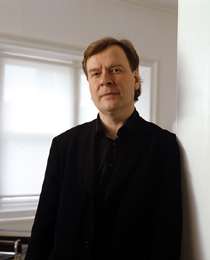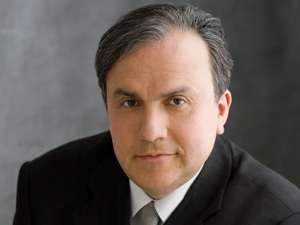|
Back
The Torrents of Spring New York
Avery Fisher Hall, Lincoln Center
05/03/2012 - & May 4, 5 (New York), 9 (Los Angeles), 13 (San Francisco) 2012
Antonín Dvorák: Carnival, Opus 92
Magnus Lindberg: Piano Concerto No. 2 (World Premiere)
Pyotr Ilyich Tchaikovsky: Symphony No. 4 in F minor, Opus 36
Yefim Bronfman (Pianist)
New York Philharmonic Orchestra, Alan Gilbert (Conductor)

M. Lindberg (© Hanya Chlala)
”Now bid me run, And I will strive with things impossible.”
Shakespeare, Julius Caesar
Magnus Lindberg, celebrating his third year as Composer-in-Residence with the New York Philharmonic obviously “bade Bronfman run”, and those fingers did indeed strive with “things impossible.”
For after the last measures of this 30-minute world premiere (New York Philharmonic Co-Commission with the Royal Concertgebouw Orchestra and the Gothenburg Symphony), the first word that came to mind for the soloist was “dangerous.” Specifically, Mr. Bronfman’s part in Magnus Lindberg’s Second Piano Concerto was so dangerously close to impossible that one had the feeling he might slip away from this most meticulous and rigorous full-time cadenza into an infernal chaos.
But this is unfair. Yes, the solo part is a dazzling, daunting non-stop tour de force. But one could never forget the meticulous, complex process which went into the making. Magnus Lindberg hasn’t “evolved”, for that is not the task of a composer. In this Concerto, though, he has reached a level of transparency which was rare in his previous work.
Much of his previous music came close to being as opaque as it was intelligent. The complexities were so blatant that one marveled more than one was moved. Mr. Lindberg is not the repenting kind: “Only the extreme is interesting,” he once said, and those extremes became part of his persona.
The Second Piano Concerto is relatively conservative. The only extreme was in the hands (literally) of Mr. Bronfman. The music itself, three connected movements, came near to quoting a work written eighty years ago, Ravel’s Concerto For the Left Hand. The opening blurred bass notes blossoming into major themes was almost a direct homage. The glittering fingering was close to the Ravel touch. Even some of the orchestral harmonies had the light Ravel character. Nor was Mr. Lindberg afraid to add some lush orchestral harmonies, the kind of sounds which, give or take a few tone clusters, could have been written by any composer of the 20th Century.
Thematically, Mr. Lindberg has compared the repetition of the themes to watching actors coming in and out of a play. And indeed, nothing felt unfamiliar here. No tone rows, no eclectic mathematical equations for Mr. Lindberg.
The composer has always felt the orchestra to be his favorite instrument, and here, he created the right colors. Two or three times, the whole orchestra played a major chord of such intensity that it could have come from an organ. But mainly he used the instruments sparingly with the piano. Lots of percussion, of course, lots of tinkling bells, solo winds and runs up and down the scale, to almost rival that of the soloist.

Y. Bronfman (© Dario Acosta)
But this was no “concerto for piano and orchestra.” Hardly 20 seconds into the work, Mr. Bronfman began to essay those intricate, involved torrential marathons up and down the octaves. The complexities were as arduous as the tempos, but the sounds were ravishingly beautiful.
The second section was a bit slower, and here Mr. Bronfman almost had time to ruminate. Not pause, but to take his time, to enjoy the drama, to suddenly have a short pleasant dialogue with timpani or solo violin. Nothing was easy, but we had time to listen to Mr. Lindberg’s inspiration before continuing on this most extraordinary voyage.
One note puzzled me in the program. It read: “Cadenza: composed by Magnus Lindberg.” Yes, there were moments when Mr. Bronfman played a few measures without orchestra, and any of these could be considered a “cadenza.” But the entire Second Piano Concerto could be considered a cadenza by itself.
One has no doubt that it could be one of the staples of early 21st Century music making. But one must ask who–outside of Yefim Bronfman–can master the Concerto’s technical demands? It is indeed, as the Bard said, “a thing impossible.”
For the record, Alan Gilbert, who corralled his orchestra well in the Lindberg piece, started with Dvorák’s Carnival, that delicious furiant, with the luscious nature theme, and the half-dozen mock-Beethoven bogus endings. (Not that the gentle Dvorák would ever mock anything.)
Confessedly, after Alan Gilbert’s emotion-draining performance of Mahler’s Sixth Symphony on Wednesday, and Mr. Bronfman’s massive exercise last night, I was unable to take on a Tchaikovsky symphony as well. No doubt Mr. Gilbert would do his usual excellent job, but, unlike the superhuman soloist tonight, my own stamina is sadly all too human.
Harry Rolnick
|